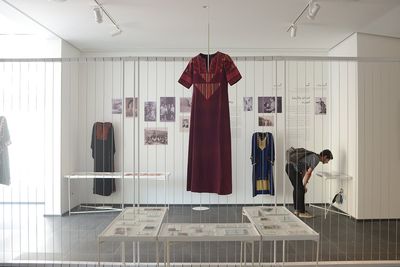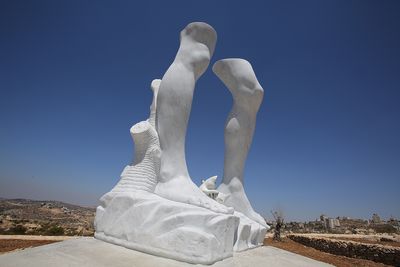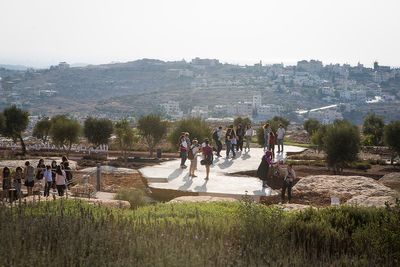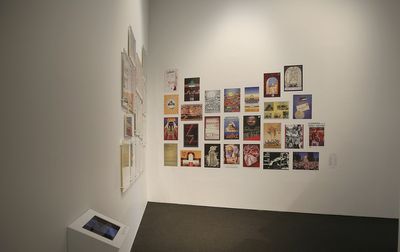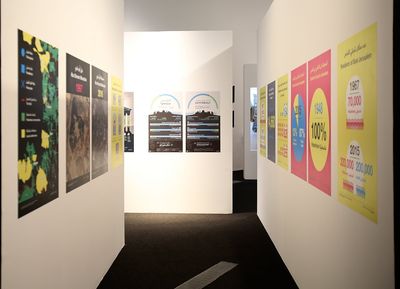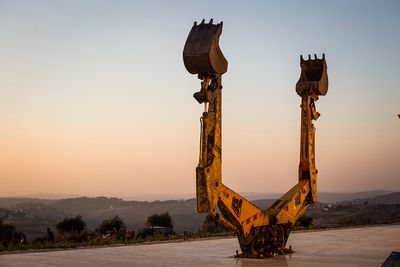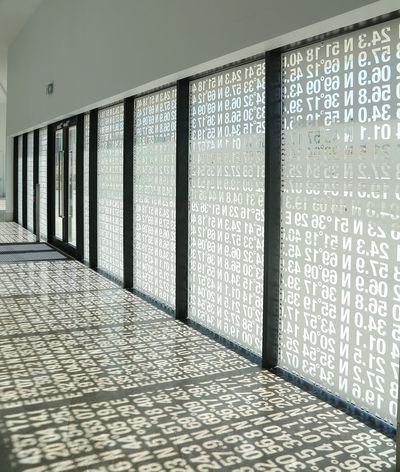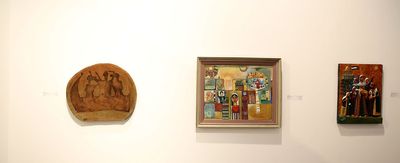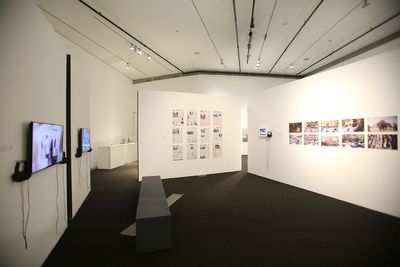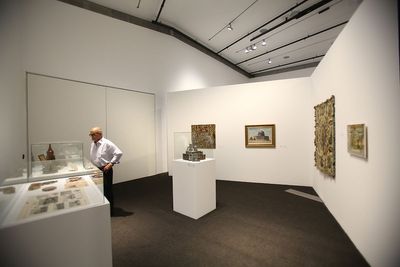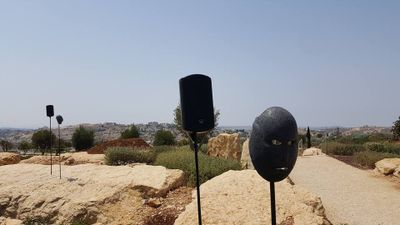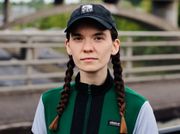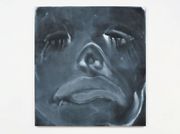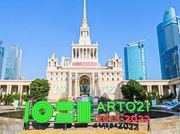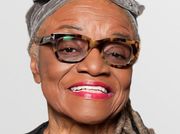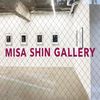Reem Fadda
Reem Fadda. Photo: Sofia Dadourian.
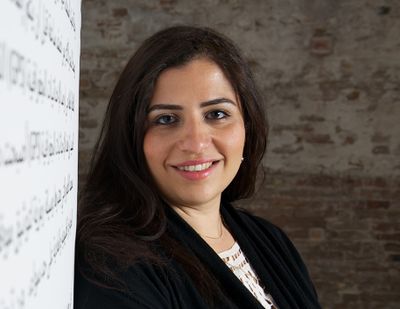
Reem Fadda. Photo: Sofia Dadourian.
The Palestinian Museum, located in Birzeit, a town north of Ramallah in the occupied West Bank, opened its doors to the public in May 2016. The museum seeks to connect communities across historic Palestine and the diaspora, who cannot access its main site due to Israel's exclusionary closure policies, by hosting satellite exhibitions with partnering institutions. The Museum's first exhibition, At the Seams: A Political History of Palestinian Embroidery (25 May–30 July 2016) curated by Rachel Dedman, was held at Dar El-Nimer in Beirut at the time of the museum's opening. (A new iteration will be showing in Birzeit March 2018.)
Over a year later in August 2017, the museum opened its inaugural exhibition in its actual space: Jerusalem Lives (Tahyah Al Quds) (27 August 2017–31 January 2018). Curated by Reem Fadda, the show seeks to examine the cultural, political, economic and ideological layers of the city in relation to globalisation and its discontents. As one of the most politically contested cities in the world, Jerusalem has become a pressure-point where neoliberalism and settler colonialism intersect. This year also marks the centenary of the Balfour Declaration and the fiftieth anniversary of the Six-Day War of 1967, which led to Israel's military occupation of the West Bank, the Gaza strip, the Golan Heights and the annexation of East Jerusalem. Whilst these watershed moments are central to understanding Palestine's political and spatial fragmentations, and Jerusalem's position within this shrinking geography, the city holds greater historic and cultural resonance for Palestinians beyond such turning points.
Central to this show, then, is the role artists and activists have played in providing an alternative blueprint for the city of Jerusalem. Through audio-visual materials and a series of new sculptural commissions staged in the Museum's garden by Palestinian and international artists, including Adrián Villar Rojas, Athar Jaber, Emily Jacir and Bob Gramsma, as well as partnering with various institutions in Jerusalem including the African Community Society, Arab Studies Association and the Jerusalem Quarterly, the exhibition seeks to invoke solidarity across borders in the face of continued Israeli aggression. (This is reflected in the show's title, which recalls the popular slogan, Tahya Falasteen, which translates in English to 'Long Live Palestine'). It is from this uncertain future of 'caged colonialism'—a term borrowed from participating artist Vera Tamari—that the exhibition asks: How does the dream of Jerusalem as global and free transform into a gated and restricted city? And, under such conditions, how can we move beyond the city to lay bare questions around Palestine's sociopolitical and economic future?
In this conversation, Jerusalem Lives curator Reem Fadda talks with writer and scholar Reema Salha Fadda about the curatorial approach guiding the exhibition, opening up to a more general conversation about the evolution of cultural production in Palestine.
RFI want to start by asking you about the theme for the inaugural exhibition, Jerusalem Lives (Tahyah Al Quds), which seeks to frame Jerusalem as a laboratory for global political, economic and ideological concerns. Why did you focus on this theme for the inaugural exhibition?
RFTo start backwards, I was not the one to choose the theme of Jerusalem. It was preordained from the Board of the Museum who wanted to focus on the city. This of course makes sense given this year is the fiftieth anniversary of the Six-Day War. However, I made it a point to expand the idea of Jerusalem beyond a historical turning point. The city has existed for me, and for many others, prior to and after the events of 1967, so it's not the marker that defines Jerusalem for us. Personally, I felt very connected to the exhibition's focus given the city's future is a very important topic to engage with in the present.
When I returned to Palestine from the US, it was during the time Trump had declared moving the US Embassy to Jerusalem, which gives an indication that the fight for Palestine will be in Jerusalem. It triggered many questions, namely, how do we resist in Jerusalem? In response, the way I have approached the exhibition is to look at Jerusalem from a global perspective. I am offering a metaphorical thesis in which I'm saying Jerusalem is the quintessential global city, and because globalisation fails there, its failure is exported elsewhere in the world.
RFThe exhibition is a multi-part project of four chapters that include: an exhibition that explores the effects and limitations of globalisation in the city of Jerusalem; site specific works in the Museum's garden; collaborations with partner institutions in the city; and a publication on knowledge production as the frontier of resistance. Can you explain how the different parts function and work together?
RFI have four components for the exhibition. A central exhibition, that studies where we are and takes on the necessity of drawing attention on what is happening to Jerusalem in a very direct way to multiple audiences. I am galvanising the gallery space as a site to demonstrate everything that has happened to the city in our contemporary times. Through mainly audio-visual materials, I am looking at four layers to study globalisation through the city: the cultural, the political, the economic and the ideological. The main questions I am asking are: What is the media image-making of the city? What is the stereotypical image of the city? How is it being produced in the mindset of people? How is it being activated or not being activated? What are the facile, neoliberal ways of looking at a city as a global city, and what are the failings of this approach? When the city becomes so extended to the point of symbols, how do we create a new articulation of the city? I am also consciously focusing on the people that make up the living aspect of the city and how do we help mobilise them and support them in the face of this closure and oppression.
Within this space, I look to how artists have always looked critically at our relationship to the image of Jerusalem and our relationship to the city, to show the role they have played in slowly absorbing and articulating these criticisms. We seek to highlight the ways in which artists have abstracted the image of Jerusalem, giving us space to think and creatively breathe.
To highlight the political dimension, we have produced infographs collected by various institutions and individuals, on the Judaisation policies re-shaping the city, including the house demolitions, the wall, the checkpoints, and impositions that are being inserted into the city as a result of urban planning to show how politically and racially motivated this process is in order to make it an exclusionary city for one group of people. We have also commissioned Ahed Izhiman, a Jerusalem-based photographer, to produce a photographic installation where we show how Israel's settlement expansion is circling the city. The display mirrors this circle so that audiences understand the infrastructure being developed on the ground, which of course is part-and-part of the military industrial complex that the Israelis have created. Just recently, Israel placed metal detectors at Al Aqsa Mosque, which is just one symptom that shows how Jerusalem is one of the most surveilled cities in the world. The Israelis have created a modern surveillance unit that they have been exporting globally, with EU delegations coming to see these places.
RFSo what you're saying is that the city has become an exhibition site for the military industry and surveillance?
RFExactly. Beyond issues of militarisation, taxes are enforced that have led to the closure of Palestinian-owned shops in the Old City. It is for this reason I decided not to host workshops, film screenings and performances as part of the public programme. Instead, I contacted Jerusalem-based institutions and asked them what they would like me to do for them. Some wanted me to print books: for example, Al Hakawati Theatre in Jerusalem wanted to do a remake of a play they did in the 1980s, so we're supporting them with funding; the African Community Society wanted to create instruments that are part of their heritage and stage a concert, so we're working with music associations to produce those instruments. Our aim is to create a chain of solidarity among these institutions in Jerusalem to respond to their actual needs and to ensure they continue operating and existing in the city. This is at least a symbolic, social, cultural and political form of resistance.
The last chapter of Jerusalem Lives is the catalogue we are producing in collaboration with the Jerusalem Quarterly. I asked its editor Salim Tamari to produce a special issue, and he chose to focus on the biographies of the 12 most important Jerusalemites, and he called the issue Jerusalem Lives—that's where the title of the exhibition came from, actually, and it includes an amalgamation of essays from the Palestinian Studies journal archive. This collection informs the spine of the Jerusalem Lives exhibition catalogue.
RFThe curatorial statement for Jerusalem Lives is driven by a very specific political inquiry—how did this shape the artistic responses? Here I am thinking specifically of the new commissions that were produced for the show.
RFThe majority of works are new commissions. Some are older works that have been adapted in line with the site specificity of the Museum itself. For example, in the garden area, Nida Sinnokrot's KA (Oslo) (2009/2017)—which was first produced for the 2009 Sharjah Biennial—includes large-scale bulldozer JCB arms from 1993 that appear to be praying to the sky. Emily Jacir's Untitled (servees) (2008/2017), which was first shown at the Jerusalem show at Al-Ma'mal, has been placed in the Museum's parking lot.
In terms of new commissions, Khalid Hourani's Compass (2017) is a piece that requires the viewer to look through binoculars to search for a ceramic sculpture erected in an adjacent village, Abu Chkhaidem. The sculpture, which reads in Arabic, 'A compass does not lead to Jerusalem', evokes the idea of not being enclosed in how we look at things, and to consider perspectives beyond the horizon. Oscar Murillo has taken an ongoing project, for which he creates a series of black paintings that are produced with members of his family and community, and expanded his circle of collaborators by partnering with institutions in Jerusalem, such as the Silwan Club and the African Community Society, creating what he calls 'the institute of reconciliation'. The idea is to create a more permanent workshop structure where he supports the collaborators financially, offering another example of how we seek to work with institutions in Jerusalem.
Of course I have the issue of artists who are unable to access the Museum site: Mohammed Kazem from the UAE, Iman Issa from Egypt and Sultan bin Fahad from Saudi, are unable to visit Palestine and so we staged their commissions by their instructions.
RFI want to return to this idea of the city as a laboratory for understanding globalisation and its failures. The curatorial statement seems to draw on many questions being raised by academic discourse that seek to frame Palestine beyond an exceptional nationalist framework, in which cities in Palestine are framed as laboratories to think about the 'global'. I am here thinking of Gaza as a laboratory for the military industrial complex, or Ramallah as a case-study to think of neoliberalism in the context of ongoing settler colonialism. As such, how does the exhibition seek to develop these critiques and discourses? And in what way does the Museum have the potential to create new artistic and political alliances?
RFOne of the main audiences is the Palestinian youth and the younger generation. The idea is for them to think holistically and strategically about Jerusalem, not in isolation of everything else that is happening globally. I am also presenting the entire discourse on Jerusalem to Palestinian audiences and of course for international audiences who want to cover this show, in order to see reality on the ground and to understand what's happening. I don't want to simplify it too much, but if you're a Parisian and you come and see this show, maybe this gives you an idea that the solutions for security and surveillance are a recipe for disaster for their own states. And so, when that realisation comes to the fore, and a well-educated person starts to understand that these are exclusionary cultural methods, we are beginning to build a consciousness world wide, vis-à-vis what is happening in Jerusalem.
I am someone who has not forsaken the exhibitionary model, but I have sought to push the boundaries of artistic practice to be more vitally responsible to a pertinent and urgent political thing for society. Nor have I forsaken the language of aesthetics and beauty and the necessity for that, because we are in need of that, even for our ability to persevere—it's an absolute human need and I insist on it. However, I have pushed the boundary of the artwork—it doesn't just exist as an artwork that lives in a white cube, but something that goes beyond that into the landscape, into the people, and thinking about site specificity, it's not necessarily about longevity—it's a gesture. There's a lot of things in the vocabulary because at the end of the day there is a pressing question: do you maintain art or do you maintain lives. Of course neoliberal economies are a force that is beyond us but where are the chasms in-between that we can use to push the boundaries to evoke some sort of eruption and change.
A museum built here in Palestine is really built with a lot of consciousness, of space, of landscape, of people, of the cause—and so it's not responding to the idea of just making global connections or simply hosting an archeological show. We still have livelihoods to worry about, the living to worry about. So the path this Museum is on is a very interesting thing to explore when it comes to thinking about the possibilities and the potential of how a museum can push for a society.
RFYou've played an important role in developing cultural institutions in Palestine, namely the Academy of Art, which has mobilised the career of many young artists in Palestine. More generally, what shifts have you noticed in the cultural scene in Palestine during your time working there?
RFI think we're finally getting what it means to build institutions that have permanence. We're very well prepared and in a strong position to carry this through. As you say, I've been in the cultural scene for 20 years, and I remember when each centre was doing their own thing, but now there's a mass collectivism to work and build the cultural scene together. There's no petty competition, but real solidarity. We can see this from the Qalandiya International initiatives. Though it took them time, they built a network of institutions, which points to how we have come to understand the importance of building up and together. This is a fascinating point about the cultural scene actually—that it has always been built from the bottom up. It was never a top-down structure. Take the A.M. Qattan Foundation, which has always been doing things from the ground up and slowly building satellite institutions in Gaza and London, while hosting exhibitions in Amman and elsewhere. Now, they're saying, 'let's build an infrastructure to fully reflect the depth of this institution and its growth'.
Of course, having said that, I also want to shed light on other cultural centres like the Khalil Sakakini Cultural Center, who up until last year did not have enough funding to run, but survived through alternative models—of volunteering by artists and cultural interlocutors who pitched in to ensure its continuation. So the shift towards new institution building does not preclude smaller scale models either; everything co-exists. Also, we need to understand, that in the Palestinian cultural scene the erasure of our past, our consciousness, our history of making and producing, and our archives, is not a facile thing. The Israeli's have targeted our cultural centres and infrastructure every single time, and you have to start from scratch.
Even in terms of the Museum, it's taken the team years to consider how to develop the project and this has involved many deliberations. We would not have been ready for this 20 or 10 years ago, but we are ready for this now. And it's fascinating when you have a museum built that is about land and not simply an exhibition hall—it has just one small exhibition hall, so it's not about 'giganticism' but about a different need for society. It is really on the pulse of what a museum needs to be for the 21st century and for Palestine as well.
RFI agree. I have argued elsewhere that this Museum's global reach might offer a way to mitigate ongoing cultural destruction by building a site of permanence that is visible on the world stage. The Museum's position within a networked art community may invite greater trans-national cultural solidarity.
RFI would even say there is much more we can do in terms of providing new models of building cultural institutions that resonate with societies, as a holistic form and model of building infrastructures that speak to creating new global institutions. We need to demonstrate these are the model ways of making exhibitions that relate to societies. What I could never do in New York City, I can do in Palestine, because this is where the neoliberal economy is still not yet forged in steel. It's moulded in clay and I can still work through the cracks.—[O]

